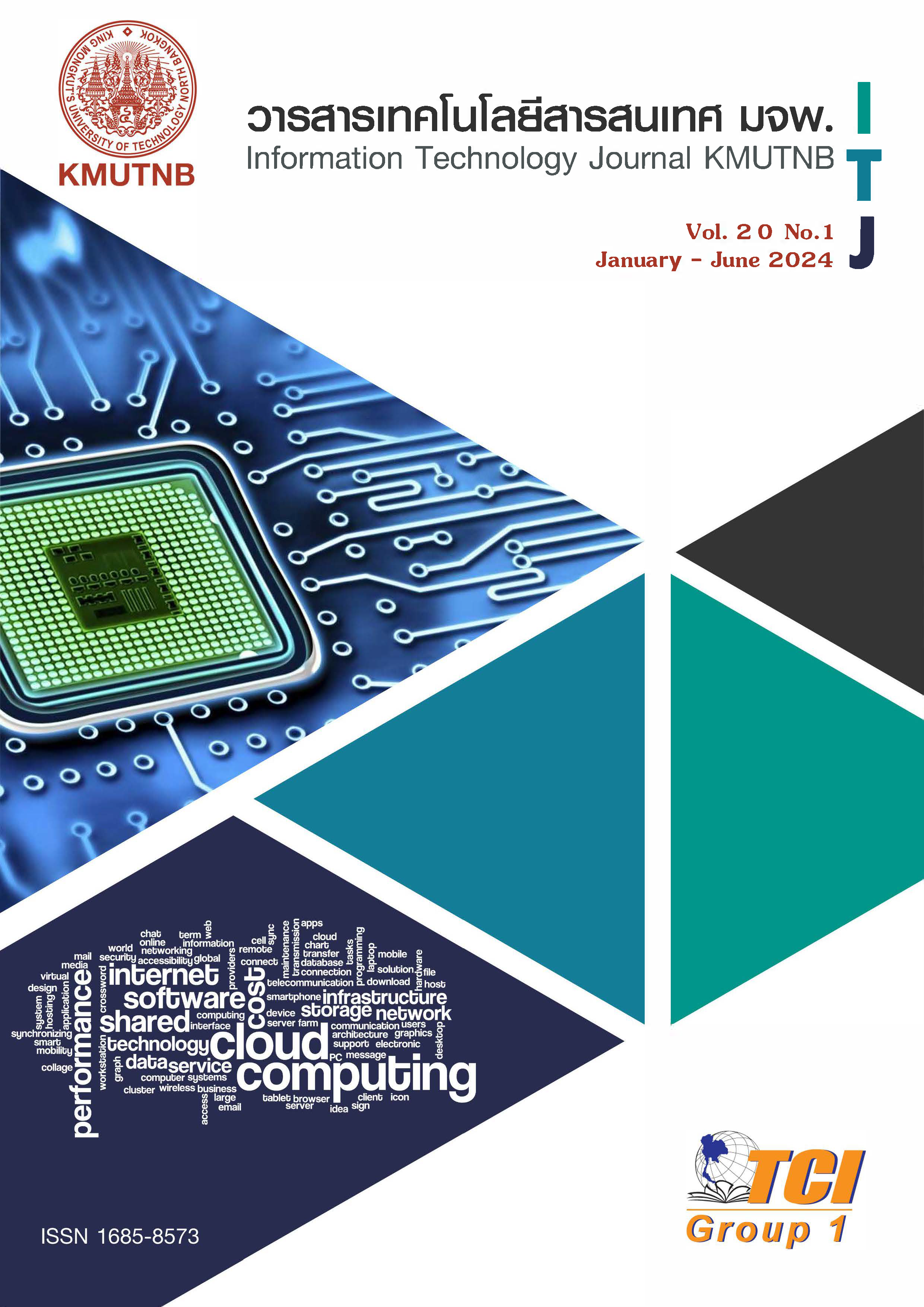การศึกษาคุณลักษณะที่ส่งผลต่อผลการทดสอบทักษะความเข้าใจและใช้เทคโนโลยีดิจิทัล และเปรียบเทียบประสิทธิภาพการจำแนกข้อมูล โดยใช้เทคนิคการทำเหมืองข้อมูล
Main Article Content
บทคัดย่อ
งานวิจัยนี้มีวัตถุประสงค์เพื่อศึกษาคุณลักษณะที่ส่งผลต่อผลการทดสอบทักษะความเข้าใจและใช้เทคโนโลยีดิจิทัล โดยใช้เทคนิคการคัดเลือกคุณลักษณะ และเพื่อเปรียบเทียบประสิทธิภาพการจำแนกข้อมูลผลการทดสอบทักษะความเข้าใจและใช้เทคโนโลยีดิจิทัล โดยใช้เทคนิคการทำเหมืองข้อมูล กระบวนการวิจัยเป็นไปตามขั้นตอนของ CRISP- DM ศึกษาและรวบรวมข้อมูลผลการสำรวจและประเมินสถานภาพการเข้าใจดิจิทัลของสำนักงานคณะกรรมการดิจิทัลเพื่อเศรษฐกิจและสังคมแห่งชาติ ระหว่างวันที่ 1 มกราคม 2564 – 30 กันยายน 2564 จำนวน 12,374 ระเบียน 67 คุณลักษณะ ดำเนินการคัดเลือกข้อมูล กลั่นกรองข้อมูล แปลงข้อมูลให้อยู่ในรูปแบบที่เหมาะสม ทำการเพิ่มความสมดุลของข้อมูลด้วยวิธีการสังเคราะห์ข้อมูลเพิ่ม (Synthetic Minority Oversampling Technique: SMOTE) คัดเลือกคุณลักษณะด้วยเทคนิคการคำนวณหาค่าน้ำหนัก ได้แก่ 1) Chi-Square Statistic 2) Gini Index 3) Gain Ratio 4) Information Gain และ 5) Correlation based นำผลค่าน้ำหนักสูงสุดที่คำนวณได้ 10 ลำดับแรกของแต่ละเทคนิคไปคำนวณความถี่และคัดเลือกคุณลักษณะที่มีความถี่ตั้งแต่ 2 ไปออกแบบและสร้างแบบจำลองการพยากรณ์ จำนวน 5 เทคนิค ได้แก่ เทคนิคต้นไม้ตัดสินใจ เทคนิคเกรเดียนท์บูตทรีส เทคนิคแรนดอมฟอร์เรสต์ เทคนิคนาอีฟเบย์ และ เทคนิคการเรียนรู้เชิงลึก การวัดประสิทธิภาพแบบจำลองการพยากรณ์ด้วยวิธี K-Fold Cross Validation Test แบ่งข้อมูลออกเป็น 10 ส่วน 20 ส่วน และ 30 ส่วน วัดค่าความแม่นยำ ค่าเรียกกลับ ค่าความจำเพาะ ค่าความถูกต้อง ค่าประสิทธิภาพโดยรวม และค่าเฉลี่ยเรขาคณิต ผลการศึกษาคุณลักษณะของผู้ทดสอบที่ส่งผลต่อผลการทดสอบทักษะความเข้าใจและใช้เทคโนโลยีดิจิทัล พบว่าคุณลักษณะที่มีความถี่ระดับสูงสุด ความถี่ 5 มีจำนวน 6 คุณลักษณะ ได้แก่ การใช้สื่อประกาศ/ป้ายฉลากสินค้า การใช้สื่อดิจิทัลเพื่อโซเชียลมีเดีย การใช้สื่อดิจิทัลเพื่อเข้าถึงเว็บไซต์ ปัญหาค่าอินเทอร์เน็ตแพง ปัญหาการเข้าถึงพื้นที่บริการอินเทอร์เน็ต และ ปัญหาข้อความสแปม/โฆษณา ผลการเปรียบเทียบประสิทธิภาพการจำแนกข้อมูลผลการทดสอบทักษะความเข้าใจและใช้เทคโนโลยีดิจิทัล พบว่าเทคนิคแรนดอมฟอร์เรสต์มีประสิทธิภาพการจำแนกข้อมูลมากสุด เมื่อแบ่งชุดข้อมูลออกเป็น 30 ส่วน มีค่าความถูกต้อง 76.29% ค่าประสิทธิภาพโดยรวม 76.00% และค่าเฉลี่ยเรขาคณิต 76.28%
Article Details
เอกสารอ้างอิง
R. Ratanabanchuen. The digital economy and the readiness of Thai households through the study of "Digital literacy". Available Online at https://www.pier.or.th/abridged/2021/04/, accessed on 15 October 2022.
National Statistical Office, Ministry of Digital Economy and Society. The 2022 Household Survey on the Use of Information and Communication Technology, National Statistical Office, 2022.
Office of National Digital Economy and Society Commission, Media and Information Literacy Summary Survey Report Thailand 2019, Ministry of Digital Economy and Society, 2022.
P. Kularb. "The Promotion of Media, Information, and Digital Literacy for Children and Youth: Case Studies from South Korea, Singapore, and the United Kingdom." Journalism, Vol. 13, No. 2, pp. 130, May, 2020.
A. Boonyoo. "What is Digital Literacy." Journal of the Department of Science Service, Ministry of Science and Technology, Vol. 66, No. 207, pp. 28-29, May, 2018.
P. Thanathamathee, and Y. Sirisathitkul. "Improved Classification Techniques for Imbalanced Data Sets of Elderly’s Knee Osteoarthritis." Science and Technology Journal, Vol. 27, No. 6, pp.1164 - 1178, November - December, 2019.
P. Laopilai, and C. Sanrach. "Analysis for Student Dropout in Undergraduate Using Data Mining Technique." The Science Journal of Phetchaburi Rajabhat University, Vol. 16, No. 2, pp. 61-71, 2019.
S. Sinlapasorn. "Modeling used to predict osteoarthritis scores WOMAC of Post-Knee Replacement Surgery Patients with Characteristic Engineering and Machine Learning Techniques." Proceedings of the 25th Annual Meeting in Mathematics (AMM 2021), 2021.
B. Leo. "Random Forests." Machine Learning, vol. 45, No. 1, pp. 5 - 32, 2001.
A. Chutipascharoen, and C. Sanrach. "A Comparison of the Efficiency of Algorithms and Feature Selection Methods for Predicting the Success of Personal Overseas Money Transfer." KKU Research Journal of Humanities and Social Sciences, Vol. 3, No. 6, pp. 105 - 113, 2018.
ABB Corporate Research Center. What is Deep Learning?. Available Online at www.new.abb. com/news/detail/58004/deep-learning, accessed on 1 November 2021.
S. Chayatummagoon, and P. Chongstitvatana. "Image classification of sugar crystal with deep learning." 2021 13th International Conference on Knowledge and Smart Technology (KST), Bangsaen, Chonburi, Thailand, pp. 118 - 122, 2022.
K. Haruehansapong. "Digital Literacy of Undergraduate Students at Walailak University." Walailak Journal of Learning Innovations, Vol. 5, No. 2, pp. 27 - 40, December, 2019.
W. Kesornsit, J. Jitthavech and V. Lorchirachoonkul. "Reducing Multiclass to Binary for Classification Techniquesof Re-Hospitalization of Diabetes Patients." Thai Science and Technology Journal (TSTJ), Vol. 28, No. 1, January, 2020.
W. Jaidee, and N. Wannapee. "The Study of Factors Affecting for On-time Graduation of Ungraduated Student Using Feature Selection Technique on Imbalanced Datasets." Journal of Information Science and Technology (JIST), Vol. 10, No. 1, pp. 75 - 84, June, 2020.
S. Suepitak, B. Nissaidee, and W. Buathong. "Classification Techniques Comparison for Predicting Graduate Trend." PKRU SciTech J., Vol. 5, No. 2, pp. 42 - 50, December, 2021.
A. Kittitanachai. The using Information and Technology behavior which Relates for capability of Srinakarinwirot University Prasarnmit Demonstration School secondary, Presented in Partial Fulfillment of the Requirements for the Master of Education Degree in Educational Technology at Srinakharinwirot University, 2012.
T. Phiasai, and N. Chinpanthana. "Comparison of Feature Selection Method with ReliefF base Multi Label Algorithm to Improve Semantic Image Classification." Journal of Information Science and Technology (JIST), Vol. 11, No. 1, pp. 88 - 96, June, 2021.
V. Nuipian, and P. Meesut. "Comparison of filtering and consolidation techniques of text mining for text classification." The Journal of Industrial Technology, Vol. 9, No. 3, pp.118 - 129, September -December, 2013.
K. Rothjanawan, and W. Phetjirachotkul. "Feature Selection Methods for Imputation Missing Values of Time Series Data using Data Mining." Princess of Naradhiwas University Journal (PNUJR), Vol. 13, No. 2, pp. 326 - 341, May, 2021.


